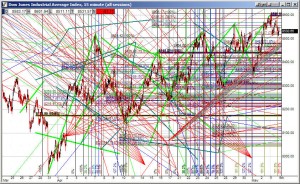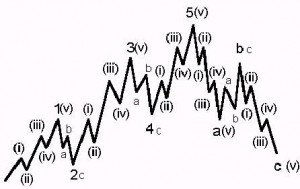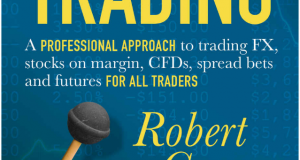The poor reputation of technical analysis is well deserved. It’s their own fault really. The way this field has expanded makes it very difficult to take it seriously. It’s been reduced to a slogan used by scam artists to sell nonsense books, trading systems, newsletters and ‘mentoring’ based on quasi religious numerology and mysticism. Professionals stay clear of the term technical analysis for good reason.
What is technical analysis?
Well, that’s just the problem, isn’t it. There is no definition. Anyone can make up anything and call it technical analysis. The field now seem to encompass everything from drawing trend lines to astrology.
Technical analysis started out with quite simple concepts, which are not all that dumb. In the early days, it was about looking for directional trends in prices and divergences between related market indexes. Experience told traders that when prices start moving in one direction, they are more likely to continue than to reverse. Technical analysis was just a way to visualize this concept.
Divergences was mostly about comparing the Dow Jones Industrial with the Dow Jones Transport, the two most important indexes at the time, and draw conclusions from potential differences.
Adding things like simple oversold/overbought indicators is still in the realm of sanity. Again, experience had taught traders that extreme short term moves are often followed by a sudden pullback. Emotions run wild as the price takes off, propelling the price further until a short term correction sets in when the buyers are already in and there’s no one left to push the price higher. Common sense things where technical analysis was used as a tool to visualize abstract phenomena.
Then the problems set it. The visual nature of technical analysis lends itself to get-rich-quick stories. After all, there’s no need for all that hard work, right? Why waste time learning tough things and gaining real life experience when all you have to do is look at a chart and draw some lines? It was only a matter of time before this field was completely taken over by snake oil salesmen. To be fair, some of them are probably just delusional and not outright immoral.
There are no rules for what technical analysis is. So it became everything. In particular, everything that is easily sold. The more colorful naming and background story, the easier the sell.
At first we had the indicator explosion. An easy way to get famous in the field is to create an indicator. Especially if you manage to get that indicator included in standard technical analysis software packages. So everyone and his grandmother started making indicators in hopes of fame. It’s a comfortable illusion, that all you need is to find the right indicators and you’ll be rich in no time at all. Just get those parameters right.
Then we have the field of exotic names. Doji, three little soldiers, spinning dragons, crouching tigers, ichimoko, harami, spanking monkeys, and tons of more colorful names. Well, I might have made some of them up, but if others are allowed to make up random exotic names, why can’t I? Beware of anything that sounds ‘cool’. Most likely it has no other use than to sell products that won’t help you.
Down the rabbit hole we go
The next step is the outright lunacy. The world of utter fantasy. You might want to drop some acid before going down this route to help the suspension of belief. You see, there are these magical numbers that govern the fate of the universe, which control everything in the world, from the formation of galaxies to the horns of goats to the behavior pattern of humans and by dividing these magical numbers found by a genius Italian rabbit counting mathematician named Leonardo a few hundred years ago you get equally magical ratios which you can use to predict stock price moves to the exact decimal and make tons of money, if you just buy the right books and courses first.
Fibonacci numbers are for the mathematically challenged. Sure, you can go ahead and flame me now. I’ll wait.
With a little creativity you can fit anything you want to a Fibonacci retracement, projection etc. The apparent precision that the decimals imply is just another layer of the illusion. Instead of saying that sometimes prices move back by around a third, this silly back story would have you believe that the prices should move exactly 38.1966%. I wonder if you’re supposed to use this on price series or total return series? How exactly should you adjust futures prices for term structure to be able to take advantage of this precision? Does it work both on spot and on future, and given the term structure, is that even possible? These questions are never answered, since these numerology approaches are used by people who don’t understand the real life problems it implies.
Speaking of colorful back stories, how about a magical set of wave patterns which also govern everything in the universe? You see, everything in the universe moves up in a formation of five waves and them move down in a formation of three waves. If you can look at a chart and figure out which wave we are in you can use the magical numbers described above to predict exactly where the prices will turn. And when you turn out to be incorrect, you can always revert to your secondary wave count. Or tertiary. The leader of the Wave Cult has been predicting the end of the world for decades and whenever the markets are falling, he’s interviewed on TV about his accurate predictions. Kinda like hailing the genius of a stopped watch for being correct twice a day.
From here it just goes down hill. Lunar cycles, planetary alignments and outright voodoo. Hell, if someone’s willing to buy it, someone else is willing to sell it. And it’s all embraced under the umbrella of technical analysis.
Technical analysis as a shortcut to riches
The seeming simplicity of just using a chart with some indicators or lines attracts many beginners. It would seem like such a great shortcut. You don’t really need to do real work, just look at a chart. Throw in a few indicators named after some authors and you’re done. It’s a seductive idea, that you don’t really need to work hard. This is why the field is attractive to retail traders and that in turn is why it’s an attractive field for those peddling products based on colorful names and back stories. You don’t even have to leave your home, just spend an hour over the weekend and beat all those silly so called professionals. Of course the pitch is going to sound appealing to newcomers.
Why is technical analysis not taken seriously?
Because the supposedly serious practitioners in the field never tried to deal with the the fringe lunatics and scam artists. Quite the opposite. The major technical analysis organizations are embracing this kind of crap and even including it in the curriculum for their courses. Of course, they are in the same boat as the people making this stuff up. The technical analysis organizations make money on membership fees. To grow membership, they need a broad base. To reach this goal, the best business plan would be to allow people to believe that there are magical numbers governing the universe and that you can get rich quick if you just learn to master this mysticism. Every member counts, even if they are impressionable marks who believe in numerology.
It’s their own fault
It’s the fault of the technical analysis industry and organizations that the field has been reduced to a mine field of scam artists and lunatics. Critical thinking is not encouraged. Simply have faith. The field has effectively turned into a religion. It’s become a joke.
There is a common understanding that you’re supposed to treat technical analysis like a science. Most books on the topic are written in such style and the courses by the major organizations approach the subject in that manner. Still they include pseudo science, numerology and outright nonsense without question or critique.
Once technical analysis was something generally accepted in the financial community. Now it’s reduced to a tag line for a collection of scams targeted at retail traders. It’s really a shame. There’s a core of useful ideas in basic technical analysis, but it’s buried under such a thick layer of bullshit that it’s not even visible anymore.
Are you saying that all technical analysts are scam artists?
No, I wouldn’t go that far. There are actually plenty of professionals using concepts originating from technical analysis. Usually they don’t use the term though, for reasons made clear above. It has a very poor reputation. Trend following, the main strategy of the 300 billion dollar CTA industry, has its roots in technical analysis. A large part of quantitative, systematic trading is based on ideas from that came out of that field.
There are even many people with the job title of technical analyst who are serious, competent and responsible professionals. They are getting fewer and fewer, but they’re out there. These are the people who need to take a stand against the scope drift of their field.
As I said, I and many others in the hedge fund business use ideas and concepts from technical analysis. We look at charts, we use the occasional indicator, draw conclusions from price patterns and run simulations to test quantitative time series theories. We work in a pragmatic manner, using what works. But we don’t deal in magical numbers, holy wave counts or the thousands of oddly named patterns and concepts which keep increasing every day to sell new junk.
Critical thinking. Question everything. Except of course if I say it. Then it’s the truth.
 Following the Trend
Following the Trend









cheers!
Are you telling me that the spanking monkey pattern bouncing off the 31.8 fibbo as part of the 2nd corrective harmonic wave isn’t going to hit the 161.87% extension? You sir, are clearly the lunatic!
Like the humour in this comment.
This guy clearly isn’t experienced in fibonacci numbers or has studied a chart using them correctly and has extensively watched how these numbers trade over and over again and again. Also, it really doesn’t matter what he thinks anyway. Why try and convince someone who is closed minded and has posted an article that discredits what you see works. What it boils down to in the end is good money management anyway. Nothing works completely (even for the best traders)…but what does work is a good risk for reward trade with stops. I will agree with his point that most of these people online charging money to show you how to trade are fakes. Why would someone who is a good trader and knows how to make money in the markets want to show others how to trade anyway? The reason is because they want to make money off others because they can’t consistently make money in the market themselves.
Fibonacci this – ppppppppplllllllhhhhhhh. What a bunch of horse hit.
The person who wrote this: “why technical analysis is shunned by professionals” then carries on to say “As I said, I and many others in the hedge fund business use ideas and concepts from technical analysis. We look at charts, we use the occasional indicator, draw conclusions from price patterns and run simulations to test quantitative time series theories”.
Think he is a but confused, and probably the reason so many hedge funds go bust. Can’t make his mind up.
Fundamental analysts: ever read the reams of rubbish online about that? It’s another terminology most would not use now. Invoice sounded academic, for those who failed to get into other professions.
And since when is a technical analyst, not a fundamentalist? Charting is simply the analysis of real time fundamentals and sentiment . Won’t find that in a newspaper or balance sheet.
We are all fundamentalists. Just different methods of dissection. I agree, some awful tech rubbish online (as there is fundamental), but I would never class somebody as professional, if not applying tech analysis to decisions. The clown who wrote this, basically said at the end, his fund trades technical analysis.
After about 1 year of chart reading I gained a feeling for the current “mood” of a chart just by a quick glance. Still, what I find helps is to have MAs (e.g. 200 EMA for long term) as a background reference to determine momentum. See how at a large consolidation all the short and longer term EMAs come together (e.g. GLD), indicating a possible major change in trend because any small change in price will typically change the direction of the longer MA’s. The “fractal” nature of a chart can make it difficult to assess the extent of a move in my opinion. It would be interesting to remove all the candles and just trade the MAs.
Sure, looking at moving averages is certainly not nut case territory. They can be great to visualize or quantify direction and change in direction and can make a valuable part of the toolkit. No need to throw out the baby with the bath water… I often use MA’s or variants thereof as trend indicators.
Thanks for your reply!
Thank you for a very well written (and correct) article. I agree with most of what you said. However, you miss certain aspects that may give even the wackiest theories in technical analysis some credence. With my background as a researching engineer and mathematician (I am a hobby quant), I scorned ideas from technical analysis such as support/resistance regardless if they originate from price series or fib numbers. I also regarded most of the indicators with suspicion and found them confusing more than clarifying. However, after a considerable time, I find many of the concepts to show a considerable validity. This observation defies my rational analysis and my only explanation to it is that there are so many traders following these concepts that it has become self-fulfilling. If this was the case, then, a trader should take these ideas in consideration. It becomes a sort of language that traders should learn to interpret and talk (through their trading). What do you think?
I’m not so sure about the common argument of self fulfilling prophecies actually. The markets are not a democracy with one person, one vote. It’s one dollar, one vote. A hundred thousand retail traders dealing in lunar cycles and waves are easy drowned out by a couple of institutional money managers. If enough capital would move into new age strategies, a few hedge funds would pop up to kill them off.
There’s also the problem of quantifying these delusions. If you get a hundred wavers in a room, they will come up with three hundred wave counts. One primary, secondary and tertiary each, and they will all be different. Ask a a hundred numerologists to draw fibonacci lines, and they’ll end up with as many variations.
Many indicators can be useful for visualizing and quantifying price structure and direction. One shouldn’t dismiss indicators outright. When using an indicator though, it’s important to understand it properly. Very few technical analysts would be able to explain the RSI formula and logic for instance but they still use it.
What gives you ‘institutional Money Managers’ the right to ‘kill off’ hundreds of thousands of retail traders and their puny accounts? The answer: your ability to control hundreds of millions of fiat money currency ‘dollars’ or ‘Euros’ or whatever, that’s all. That fiat currency is created out of nothing, by dead souls who have no understanding. Vast numbers of people, many of them poor, are being systematically destroyed by people such as yourself. When you finally come to the end of your life, you will assuredly regret the diabolical harm you have brought to so many; and rest assured, unless you stop what you are doing, you and all your bankster fiends will writhe in a richly-deserved Hell, where you will be shown no mercy, by Christ, just as you showed so many, absolutely no mercy.
Ladies and Gentlemen,
We are at this point announcing that this year’s competition for the Raving Lunatic of the Year is closing early. Clearly we have already found the winner.
Next year we’ll exclude Elbonan nationals from the competition to provide a fair chance for lunatics from other parts of the world.
Thank you for your contributions!
Many of the trend following concepts such as moving averages, Donchian channels, ATR stops originate from TA and have demonstrable value and are used by CTAs and quant hedge funds. However, the wacky end of the spectrum (cycles, Fib retracements etc.) has no demonstrable value and back test badly (if indeed it can be back tested at all). They are easy to poke fun at and they deserve to be debunked.
Support and resistance do have value in some markets and particularly in stocks. Because a few big players often have control and can (and do) return to levels at which they control supply. These might be funding levels or represents large commitments on their part. The smaller the market cap the more likely these levels are apparent. Hence trend lines (horizontal) do have validity.
Lastly the concept of momentum also has clear validity (and a vast amount of academic research supports this). We can laugh at TA (and many don’t like to be associated with the name), but we all use it!
Yep, I agree completely, Rick. You’re absolutely right. The problem is not the classic concept of TA. As you rightly say, most of us use these ideas in one shape or another. I certainly do.
But can you imagine going for a serious interview at a hedge fund, IB prop desk, asset management shop or even a mutual fund, and say that you’ve got a keen interest in TA? That might not go down very well. Well, with any luck the hedge funders might think you said T&A and hire you on the spot…
When someone says that he’s a technical analyst, there’s an overwhelming probability that he read all the get-rick-quick books and bought into numerology and financial voodoo. Mathematical arguments are met with fluffy statements about how it’s an art form that can’t be measured and that he’s heard of someone who made tons of money using these methods.
Someone who is young and want to get into the business would probably do best in not getting associated with the term. Besides, it’s better spent time to learn proper math than to memorize hundreds of indicators. I’d much rather hire someone with a solid science/math background and teach him about trading, than to hire a TA enthusiast and spend years trying deprogram him.
All fair comment. Having a genuine scientific background is a good thing (you can then write computer code and test things – if you can see it you can code it and back test it to calculate its validity as a concept).
The problem with many TA witch doctors is they expect you to sign up as a follower, and indeed this is dangerous for retail traders. Genuine education is thin on the ground and your book (and one or two others) are currently one of few that make a genuine attempt to explain top-to-bottom how real professionals function. Keep up the good work!
I came across this while reading another article, had to chime in. I dont think cycles, when learned appropriately and when referring to price cycles over time, are a bad way to learn TA.
I think they are quite simple and give excellent information about 20% of the time, which is all you need to make money.
TA is a waste of time if you try to use it for the other 80% of the time looking for things that dont exist. I would ask that one go to my blog for clarification to avoid long commenting here on the author’s blog.
Thank you
I just stumbled across your site via Google – I was portfolio manager for an extremely large and diverse hedge fund and now running my own prop firm – I am not sure what your background is but you are completely incorrect on so many fronts here. “Professionals” do indeed use technical analysis day in and day out, this I can guarantee, and I can also guarantee that they are managing far much more money than you have. And I don’t say that to stab at you, just say that you are unquestionably wrong. And many of these methods use Fibonacci derived levels for support/resistance, etc.
This is basically a hate speech, highlighted by the use of curse words. Also, CTA’s do not outperform the markets as mentioned in your database. CAGR of a diversified portfolio easily beats the historical returns of active money managers over the years. This is a fact.
I can tell you are the type that will never bend; you are definitely a member of the trend following “cult”, which is fine. Technical analysis is used to better time the markets, which is where many trend following strategies fail. Whipsaw reactions are the achilles heel of such, as highlighted by numerous funds over the years.
Anyway, one opinion hears another, so thought I would post.
Thanks for giving your views, Sean.
I seem to have stepped on some sore toes here. Calling my article hate speech is actually very interesting, as it conforms my view that numerology is religion.
As other professionals in the field of quantitative finance, I work in the realm of science. Formulating hypotheses, designing quantitative tests, analyzing results, discarding what doesn’t work, always challenging old ideas, methodologies etc. As with most in this area, I work with multiple approaches to the market, combining many types of strategies to achieve an end result. You need to constantly challenge your ideas and be ready to reevaluate them. This is a basic premise of science.
Numerology is simply outside of the realm of science. If anyone could help design a testing methodology, I’d be happy to listen. Can we find statistical indications that 38.19% is better than 33% or 35% or 40%? By what margin? How exact number is needed? Do we need to set the targets at 38.1966% or is 38% good enough? Perhaps even 35%? If so, are we still using Fibonacci numbers?
Hi Andreas , Firstly I must say it is fantastic that a pro. like yourself has the courage to slam dunk the modern day snake oil salesman [folks trying to sell programs or courses selling T.A courses ] I also note you seem to have a fairly good understanding of T.A and have tried or back tested many indicators and theories .
But I also note I didn’t see one comment on money management and T.A and how they need to be kept in context when trading . I do note some of the T.A expert teachers do combine both into trading yet it is the hardest thing to achieve .
Just incase you get bored writing and correcting some comments above I’d like to invite u to view our T.A at the link I mentioned in the heading . Many of us post purely under the heading of charts and would always welcome a view from someone who moves major lines of stock and or lines of cash .
Your eyes might also be opened to how some with limited T.A abilty like Jonny,Deb and Dick have done so well of late or some of our other quality traders like MM who rely on excellent indicators .
cheers g
One of the best article I’ve ever read on Technical Analysis. I always use to have a feeling that anyone could call them as a Technician if he could put a line and explain things using few buzzwords. Performance is the reality and most of these so called technicians lack performance rather sell their books using critical diagrams that are hard to believe but could be useful for postmortem. Nice one.
Another good one. Interesting that you include numerology, astrology and sunspots. I have to agree with your view on Fib retracements, and Elliot Wave principle. I do believe in MAs, Pivot points, support and resistance. Well I at least believe they are there and that a few make money with these.
Thanks for the read
Great article to read. I will be linking to your article in a blog post over the next day or two. Some basic use of technical analysis is sometime advisable as it can be silly to buy into a clearly “overbought” market or sell into what is a clear “oversold” market at least in the short term. So things like deviations from moving averages have their uses. Since lots of traders do use technical analysis in determing the size anddirection of their trade it is wise to use it a bit !
Interesting article, I’m not going to down your beliefs, but it’s interesting to read beliefs that contradict my own. I’m TA guy, I think trading with TA is all about risk management and having an edge on the market. My primary markets are commodities. I’m not sure how you can dismiss the various S&R information. All I will say is the more pros you have on a trade the more likely the outcome will be. TA is a tool it is not the Holly Grail. I remember when I first started trading I was a horrible technician, after seeing reactions day in and day out and not listen to the news and not caring what is really going on in the world my trading has never been better. Who cares what a company is doing. There’s art in the chart . Please answer me this question why when bad news comes out markets go up and why when good news come out markets go down? Thanks for the informative article.
Hi Paul,
I’m not sure if you actually read past the title or not. I didn’t dismiss all TA ideas. I pointed out that since any sort of pseudy-religious crap and scam artist nonsense is readily accepted as TA, the very term has lost all meaning.
Looking at logical support and resistance lines is one thing, believing in magical numbers and wave counts is a whole different thing. There’s a funny attitude in the TA community that you’re not allowed any sort of critical thinking. Anything is accepted as valid and unverified anecdotes and sales material is accepted as gospel. The field is since long dominated by scam artists with far between the few sane voices.
The TA community has decided that they are some sort of martyrs. Any suggestion about critical thinking is met with aggression as if their religion was offended. You’re either with them or against them.
As I said in the article, there’s some valid concepts in TA. There’s also very good reasons why professionals stay as far away from the term Technical Analysis as they possibly can.
Although I dismiss large amounts of TA as well, it often makes one wonder if there are gems in that which we don’t understand for example elliot wave theory and fibonacci #s. I have to say I can attest to the credibility of market structure and horizontal support and resistance levels. When it comes to elliot wave theory and fibs one wonders why such successful folks as Paul Tudor Jones, Peter Borish and many big funds subscribing to Tom Demark follow it. Perhaps they know something we don’t. Keep in mind as well Rob Prechter is a mensa member and a very bright man. Although not my cup of tea, it certainly could use some rigorous scientific testing after which one can conclude validity of these methods for themselves, I have to say it is very unappealing and difficult for me to test anything related to Gann/Astrology for example.
There’s a very dangerous way of thinking among hobby traders that I would call hero worship. It’s based on a bunch of individuals who are supposed to be regarded as trading gods and everything the say or do is gospel.
This way of thinking doesn’t make any sense and it’s very dangerous. It would be like saying that any actor who wants to succeed needs to be a devoted scientologist, because it worked for Cruise.
Never do something just because some famous person did it.
First, Prechter is a raving lunatic. I’d pay more attention to Harold Camping than to Prechter, and the two are more similar than one might think. Camping being the insane preacher who kept predicting the end of the world, and kept postponing the predicted date every time it turned out that he was wrong.
Tom DeMark is a sales guy and hardly someone to pay attention to in terms of methodology. He wants to sell his analytics, and that’s just fine.
Listen, it’s really very simple. It’s just basic critical thinking. When people claim that some ridiculous voodoo can predict the future with help of magical waves and mystical ratios, I call bullshit. No one has been able to show even the slightest indication of a predictive value of these things. This just on the same level as psychic mediums, ghost hunters, tarot card readers and every other con out there.
Of course there’s lots of money in this crap. In selling it. To others. To those who actually believe it.
Make no mistake. The use of Elliot waves, fibonacci, Gann, Astrology and such things in finance, is religion. Nothing else.
Clearly you have NO knowledge about the markets. What a bullshit article.
Thank you for your thoughtful and well argued critique.
Great response to a troll!
I’m new to investing in the stock market and after spending a few minutes watching a portion of one of those fib videos on youtube I decided that I had to stop to do some real research- I’m a senior in college majoring in finance with a minor in stats and I could smell the excrement piling pretty high.
What really set off the alarm bells at full blast were claims of people making upwards of $800k within a couple of years with a starting investments of less than $10k. What’s the CAGR one something like that? LOL
Now, isn’t the minimum requirement to day trade set at $25k by FINRA? There are plenty of similar stories out there and they are all accompanied with visuals of basement traders with subpar equipment- the visual of a poor smuck adds to the fantasy I suppose. I would think someone who goes from a net worth of a few thousand dollars to close to $1 mil would at least buy some decent equipment to work with.
At any rate, I enjoyed your article tremendously. I will thread carefully in the world of TA and stay centered with proven fundamentals.
Thanks for the great article!
Have a look at Robert Prechter, who predicted quite a few stock market crashes using Elliott wave.
Even the great Paul Tudor Jones has praised Robert’s work extensively.
Prechter is great at predicting crashes. In fact, he predicted 20 of the last 2 crashes.
He’s spent decades saying that his magical numbers predict a massive meltdown any day. Then he scores interviews every time the market dips and makes good money off gullible marks who buy his newsletter.
Prechter is not in finance. He’s not a trader. He’s not an analyst. He’s cult leader. A dooms day prophet. He’s Harold Camping.
Here’s a few interesting results, including his 79% historical failure rate: http://www.cxoadvisory.com/3525/individual-gurus/robert-prechter/
I actually Laughed Out Laughing at your reply!
A few years ago I bothered to read the ellliott wave newsletters. What a waste of money that was. Bob Prechter wrote in Jan 2010 it was the beginning of the “devastating wave III down” in the S&P500. Please take a look at the S&P500 in Jan 2010 and compare it to where it is now. Later he said his primary wave count was wrong and changed counts. Perma bears on US equities were right between 2000-2002 and 2007-2009 but wrong at all other times for the last 15 years.
Here is Bob from Sep 2010: http://www.nytimes.com/2010/07/04/your-money/04stra.html?pagewanted=all&_r=1&
“The Dow, which now stands at 9,686.48, is likely to fall well below 1,000 over perhaps five or six years as a grand market cycle comes to an end, he said”
Good post. There are a lot of crap out there and it is hard to distinguish between bullshit and stuff that may work for real.
What is your opinion on the efficient market hypothesis? Do you think markets are too efficient or is it possible to make 20-30% yearly profits by trading purely technically (just looking at price and volume)? Of course there are always going to be people making high profits, but so will there be as well if you give a million monkeys access to an account. If you think it is possible, what kind of skills do these people who can do it have? Good intuition, good statistical skills, understand mass psychology or something else?
EMH is one of many attempts to make economics and finance appear to be scientific, academic subjects. These are terms used by professors to justify their their own existence.
Really, what’s the point of such concepts? They all boil down to the same thing. Essentially, if we assume a bunch of things we all know are untrue in real life, then we can draw the following conclusions.
Here’s my Falling Off Theory: If we assume that the earth is flat, we will fall of the edge if we sail far enough to the west. It has as much bearing on cartography and navigation as most of Chicago School of Finance ideas have on asset management.
This of course in no way means that it’s easy to make money off the markets or that Analysis Method X must work. The Deficient Market Hypothesis is a joke, but that doesn’t necessarily mean that claims made by others are therefore true.
It’s a complex world. There. That’s a much more useful statement than EMH can provide.
Economics and finance have been trying to be scientific since time immemorial. I actually think the current generation of economics graduates only know how to parrot back concepts rather than actually have a deep understanding. It is a shame that history and political economics is not taught anymore. Every economics graduate will be able to solve complex utility functions using complex math such as lagrangian without understanding the point and what is the philosophical reason behind utility functions in the first place!
I disagree with your criticism of EMH though. I think it is a great theory. Academics even say that it is just a model, a benchmark if you will. It is not meant to be the truth. I think in that regard these concepts do have merit. These concepts encourage critical and creative thinking…the kind of thing that you are advocating!
Great article btw!
Interesting read, your post seems a lot less effected by bias towards Fundamentals than other articles I’ve read.
I am a beginner to Technical Analysis (currently writing a final year dissertation on Technical Indicators and Neural Networks). I am slightly concerned by all the negativity around Technical Analysis, as it is a field I have become increasingly interested in lately, and could see myself studying further.
But, I guess I’ll have to come to a conclusion on my own, before writing TA off completely.
I’m pragmatic. I don’t care to join any technical vs. fundamental fight. I do my own research and use what works for me. In the end, it doesn’t matter what label others put on your input data or methodology.
A classic argument for TA is that it’s been used for so long by so many people, that surely it has to work. This is the exact same thing said for ‘natural medicine’, to make a reasonable comparison.
People say that natural medicine has to work, because it’s been used for thousands of years. But, guess what… Then we developed tools to scientifically test it. What turned out to actually work is now called just ‘medicine’ and the rest is just a nice bowl of soup and some potpourri.
What do you make of the fact the apparently Goldman Sachs uses Elliot Wave ? 🙂
http://www.forexlive.com/blog/2015/01/26/eurusd-elliot-wave-analysis-first-target-reached-26-january-2015/
Three words. Sell. Side. Research.
The fact that some analyst, writing marketing material to generate commissions from clients uses some method doesn’t mean diddly. Sell side research is just advertisement to get you to trade. All banks and all brokers do this and it’s very profitable business.
Pay attention to sell side research at your own peril.
That’s changing in Europe – commissions in exch for sell side reports will be phased out by 2017/18, have to pay for the research as a straight up fee. Good development.
I don’t think this particular problem goes away though, Patrick. Sell side analysis has always been a bit of a copy writer job, and it’s likely to continue.
Sell side analysis reports is after all marketing material. Could you imagine a sell side analyst advising clients to step out of the markets and stay in cash for instance? That’d be a first…
True, sell side’s job in the end is to sell. Every piece they publish is to convince you to generate revenue for them, be it commissions, fees or whatever label.
Your article is interesting but also seems a bit excessively angry at technical analysis. I’m a “retail” trader and new to TA, but I must say in its defense that it has improved my trading a large degree and I have only scratched the surfice of using only basic support/resistance concepts, basic visual patterns like the tripple top reversal, and basic overbought/oversold indicators using Stochastic Oscillator.
Am I a science god who understands completely what i’m doing? Nope.. Frankly trying to understand the math behind the concepts is making my head spin.
Does the simple things i’m doing seem to be making me more money? Yes..
There is no rule that I have to be a science god to use a tool, as long as the tool is working.
Hello Mr.
I have just read this very interesting article about Technical-Analysis.
I am agree that the Technical-Analysis is not a Math as well as it is limited working, but from my experience it has a high performance on the FOREX major currencies.
In addition, i have put a link to this artciel at: http://www.engineeringinvestments.com/wp/how-does-the-technical-analyst-make-money/
You are welcome to read and write a comment !
Thank you about sharing with us your experience.
Niv Robin.
So you are saying traders who use strictly advanced technical analysis cannot be profitable?
Hi John,
If you read the article past the headline, you’ll find out that this is not what the text says.
Andreas, Somewhere on your web page just under a subscription block for Futures is a block for Equities. @ about $14.00 ? / month. I just can not locate it. Where on earth is it?
You mean this one? http://www.followingthetrend.com/join-us/
Also, more on the equity report here: http://www.followingthetrend.com/equity-momentum-report/
Hi Andreas,
Great article and I fully agreed with you. I am just starting out now as an amateur quant after having a spell in full TA world. The article also rang true for me because I know someone currently learning Gann Theory which supposedly predicts everything and I don’t subscribe to that.
What I would like to ask if which TA indicators are still usefully. At the moment I only look at EMA and SMA to track trends. I stopped looking at all the rest. Which other indicators would you still consider useful?
Hi Jon,
I’d say, just apply a common sense filter. If you understand the logic and if it makes sense, perhaps it’s useful. If it involves magical waves or formulas which you don’t fully understand, then you probably shouldn’t use it.
Never start with the toolbox. Start with the problem, and make a tool that fixes it. Many TA guys start by checking what they have, and find a problem to fix. If all you have is a hammer, you start seeing nails everywhere.
Good article! But for me it is even simpler: technical analysis (including moving averages which for some reason are still advocated) is trying to predict the future based on the past. This is ridiculous misconception continues to trap so many people. Future does not depend on the past! Future prices depend only on supply/demand in the future.
The only reason to analyse the past is to quantify the risk exposure based on historical data.
I started to believe and would like to try this so called “predictive analysis”, wootrader.com until I read your blog. And now I am having doubts… it’s probably still technical, right? What do you think?
admin edit: removed link. let’s not help these scammers improve their search rankings…
Ha, that’s funny. I’d say that’s Poe’s Law in action right there. I can’t tell if it’s a shameless scam or a clever parody. I mean, come on… Woo Trader?
The term Woo is commonly used as general term for pseudo-scientific nonsense, used to trick people into buying ridiculous stuff. Like how they sell these magnetic bracelets to idiots by saying that the magnets have some sort of health impact by harmonizing your inner blahblah… Classic woo.
You are cleaver Andreas! Thanks for your inputs
I must agree that T/A is complete non-sense. It ignores the truly complex nature of exchange micro structure, and tries to predict the future using a result as an indicator (you guessed it…price). Last time I checked, price was dictated by order flow, exchange dynamics, liquidity, and other quantifiable forces.
I think what this author is trying to tell you people is that T/A is basic and a fools errand. How do I know? Because I am a professional working on an actual institutional desk. T/A is for the suckers who do not truly understand how exchanges work. That is a fact. Professional traders are well aware of all the T/A traders and we use their false signals against them. Why wouldn’t we?
You T/A guys have NO idea how truly complex this game is. T/A is pre-school level market analysis. Save your money and go get real jobs.
Mr Clenow:
Reading your first book now–great stuff. Also interesting to read you comments on the Linda Raschke book!
I won’t go through my years of pain with all this–suffice it to say you seem to know what you are talking about–especially the painful side–and that makes me a believer–certainly versus many of the other questionable experiences I have had…
In your mind–is it possible to trade shorter term–day/week strategies versus months/years strategies [hey I am not getting any younger after all!! 🙂 ] using your approach/information—and if so would subscribing to your futures publication help with such a goal? Here is your opportunity to make a quick sale [ 🙂 again]–say the word and I am in—David
Hi David,
I read Linda’s book a long time ago and can’t really remember the details. If I recall, it left me with a positive impression though.
In my view, you always need to be aware of the currents. Understanding ongoing trends, changes in trend, relative volatility, impact of term structure, changes in term structure etc. These are the primary points I try to cover in the weekly report. Even if you trade short term, you need to be aware of these factors. They have a significant impact on probabilities. Feel free to sign up for the trial. No hard feels if you cancel before getting charged of course.
Can you drop a note to my e-mail [that I entered in the reply frame] if you respond to this? Tx so much for your help—D
Mr. Clenow,
Forgive me for contacting you about this, but I recently got and read your new book, “Stocks On The Move.” I am very anxious to begin the journey. I signed up on your website, for “Equity Momentum Trader,” on PayPal, for $14.99 per month. When I tried to access some info, it asked me to “log in.” Unfortunately, I had not gotten to that point, after setting up payment. So, I clicked on “join us,” which took me to the page to submit payment again, through PayPal. If someone can help me with this problem, I would be very appreciative, and excited to get started. Thank you, so much.
Steve Shull
Lake St. Louis, Missouri, USA
Hi Steve,
Sorry for the late reply. I just saw that your registration was already done, so I guess it got solved.
The entire process is automated, and after signing up you should get an automated email asking you to complete registration. Feel free to contact me directly if there’s any problems or if you have any requests for enhancements.
Thanks for signing up!
Andreas
Andreas:
I contacted you earlier this week about a “short term” trading question which you graciously responded to. I also have signed up now for the furthers report. Paypal shows it as complete and registered–I have received no information about how to access the information through the premium content page.
Maybe it takes while to get e-mailed?
If so sorry to pester you—I am headed out and wanted to make sure there were no problems—
Best R—David Dkiash at aol .com
Hi David,
Thanks for signing up! Sorry about the problem though. It seems like like something went wrong with the automated email. I’ll send you a mail in a moment with the details.
Andreas
Hmm, I wrote in the comment above how Paul Tudor Jones and possibly many other big fund managers follow EW theory. Andreas warned against hero worship, and I couldn’t agree more, especially when it comes to names like Gann who has been confirmed by his own son to be a fake. We also know that Prechter has been a perma bear for the last 20 years!I have to admit that I do enjoy his work in socionomics for instance.
Even if some fund managers keep an eye on wave counts and truly believe in the theory, they also use fundamental analysis of macro trends, business cycles, sentiment measures and many other approaches in confluence alongside with rigorous money management.Who knows which method really has predictable values in the end? And who’s to say that looking for wave III moves in EW isn’t just trend-following?
One main reason I distrust Elliot Wave and other complicated charting methods is because they are almost impossible to properly backtest and verify, and most EW gurus I have to admit appear suspicious!
Yes. Thank you. It needed to be said. TA is a product of mankind’s obsession with finding patterns in everything. It is no different than reading tea leaves, chicken bones, runes or stars as was aptly brought up. The fact that it is touted in mainstream investment circles as legitimate analysis is just scary.
A skilled TA views a chart like a chessboard. He studies the current trend (draws a line to visually see it), checks average numbers to see if the stock is trading above or below average, studies volume to determine excessive buying or selling support, draws visual lines under areas where the stock consolidated before moving up and down, and whatever other tool he has learned to master. These observations precede a commonsense decision to long or short a trade based on skillful analysis of the stocks past trading patterns. It does not predict the future; it allows us to analysis a stock before making a strategic long or short. The more years you study it; the better you get at it – like anything that requires 10,000 hours. I’ve studies the craft for 5 years and I make a six figure income. I’m not a millionaire, but I provide well for my family sole on technical analysis. Anyone who hasn’t spend the first 1,000 hours of study is unskilled and should stick to a strategy that works best for them.
The editor can’t even get the names of the indicators right. It’s Ichimoku. Obviously he isn’t taking into considerations the many 1000’s of highly successful traders that base their trading philosophy around technical analysis. Someone needs to lay off the koolaide.
Getting the names of the indicator right is not the point of the article.
90% of traders lose money…. I guarantee they use stupid shit like technical indicators, therefore we see those patterns exist, almost… easy to make money if you know what the other guy is doing, which in the end, is literally the name of the game.
I bet Kasparov would have liked to have been able to guess his opponents move that easily.
Hi Andreas,
I’ve got a question regarding Equity Momentum Strategy. SP500 closed above its 200MA on March 17. At the moment you’ve got only 3 stocks in your portfolio. Am I missing something, because it seems that according to rules the risk is on and the strategy should go long on a bunch of stocks?
(My guess is that you chose Friday in your code as your rebalancing day for portfolio)
Best regards,
Vitaly
Hi Vitaly,
The issue is whether you want to do weekly or monthly rebalancing. The book uses weekly, but I realized afterwards that most people are subject to capital gains taxes and high commissions. We have no capital gains taxes here and asset managers aren’t subject to them either way. For those who have such taxes or deal with higher commissions than the tiny ticket fees you pay as a fund manager, it probably makes sense to go to monthly rebalance.
Some explanations here in the docs: http://www.followingthetrend.com/premium/equity-momentum-model-documentation/
The results in the long run when using monthly rebalancing are almost the same. If you have cap gains taxes and such, the end result will be better with monthly.
Right now, the weekly model is back in while the monthly is not. The index was below the average at the start of the month. One will win, one will lose. Impossible to tell which one. Give it a year or so, and it will even out. The monthly is slower, but also less prone to whipsaws like the one we saw last Fall.
Hi Andrew, just found this site and this particular subject matter and am reading with interest. I have been trading now for just over 12 months and have been in and out of profit trying to find a system to make money. I look at some of the charts posted by individuals on sites such as Tradingview, and find it remarkable how accurate some of them prove to be. However as has been mentioned in this discussion, a stopped watch is exactly correct twice a day. I also have come to believe that many of the predicted fib retracements, support and resistance levels do in fact become self-fulfilling (rather than them simply being incredibly close to being exactly correct at times), and note that you have rejected this idea based on the difference between funds at the disposal of the big players compared to the total of all retail traders. I would comment on this that those that say it does work are selective in that they don’t make comment when it completely and utterly fails! and vice versa to a certain extent.
Now what I would really like to ask you is your opinion of Bollinger Bands and Donchian Channels? Let me explain how I have started trading, and please feel free to rip apart or otherwise my trading strategy.
Basically I am trading the Dax against the market, entering as close to possible at what appear to be reversals. If I see a big spike and watching the 10 second, 1m and 5m charts plus using Bollinger Bands and Donchian Channels plus RSI and MACD, with an eye on the Dow and USOIL, and when the index hits the upper or lower bands of at least 2 of the charts, preferably 3, then I look to enter with a small stake. If it goes 10 points or so against me, I add to a losing position…the exact antithesis of what every trading manual and video will tell you. except for Martingale. I use this method until it is clear that the market is not going to go my way anytime soon. At this point I do not exit the trades, I enter an opposite trade and ‘lock in the loss’ and then re-evaluate the position. I can now enter new separate trades one way or the other, whilst also keeping an eye on the original two trades (‘one’ consisting of the multiple trades and the other being the opposite trade or ‘blocker’ as I call it). If the market continues against my original bet, then my opposite trade is now in profit and once again I look for the reversal point to exit this trade at a profit and then let the original trade reduce the loss until a point at which I am either at break even or in profit. Thus far it seems to be working, and since adopting this refined strategy I have had success on c. 70 out of 75 trading days since the start of 2016.
I would say that out of any of the ‘technical indicators’ available, the BB/DC combination seems to work most frequently (it rarely hits the exact upper or lower channel, but near as damn it within 5-10 pips before either reversing or breaking out) and enables a trader to achieve the goal of more than 50% successful trades.
Love to hear your comments and any body else’s for that matter
The title of this article should have been “Why Fibonacci is garbage”, instead of putting the whole of technical analysis in the same bag. Most of it is statistics and it can be quite reliable, if well interpreted.
That said, I would like to add that, as a technical analyst, I find Fibonacci numbers laughable. You are 100% right about that.
Actually, the Fibonacci series (and its modified varieties, e.g. Ti = Ti-1 + Ti-3) can be useful if you need to approximate a geometric series with discrete values for some reason. Too bad the typical TA use is indeed for garbage…
The problem with statistics is that it usually assumes a normal distribution (with standard deviation, etc) but the underlying data is not coming from a normal distribution, so what exactly are you going to interpret well?
If you do what you are told by your stats, things will look fine in all the cases when it doesn’t matter, and then something happens the math says should never happen, LTCM / Fannie Mae style.
Hi Andreas Clenow,
What a mind boggling topic for Technical Analyst out there. I am pretty sure some agree with your statement and some don’t. BTW, as we all know, WD Gann is recognized to be ‘legend’ in trading world, and even him uses TA. (Full Stop) And yes, recognized, not certified or validated or any other terms in regards to his success. Unless you have a legit point to discard this recognition. I am a Technical Analyst myself in FOREX trading, I uses it because it gives my high chances/probability in making money (whenever I hit sell or buy), which is good for me. and I believe it also means something to TA out there. Now, allow me to ask you, IF Pro Trader try to avoid TA, on WHAT BASIS DO THEY HIT SELL/BUY? if they did have basis, is that ‘basis’ not consider as Analysis? which is very similar to technical analysis? or they just simply hit the button buy/sell. Because for me, I need a reason to buy or sell, and that reason comes from ‘analysis’. And please let me know how exactly do you justify your decision when you hit sell/buy? I’m sure my question is interesting enough for you to reply.
It’s interesting how people are so indoctrinated that they lash out on my articles on TA without really reading or understanding them. I suppose that if people invest enough time in believing these strange ideas, they feel threatened by any sort of critical point of view. You made my point for me. It has become a religion where people believe nonsense without having any ability left for critical thinking.
Gann is certainly an interesting role model. A self proclaimed financial guru about 100 years ago, who based his financial methods on astrology, bible readings, numerology, and superstition. It goes to show just how detached much of the hobby trading community is from the real world.
But, I have no intention of engaging in a game of Pigeon Chess here, so I’ll just leave it at that. Best of luck.
it’s undeniable most TA’s practiced their analysis religiously. especially when their analysis gives them an edge in making money. and don’t get me wrong, your article is your perspective, you can say anything you prefer. and I happen to be one of the reader, and I believe I can also reply what I prefer. You’re a good writer and I read your article many times just to understand your perspective. probably you had some bad experience with TA in your past. and I am still not sure how do you ‘follow the trend’ without a method of application, which comes from analysis. and I am pretty sure too that you will think before you reply again, by thinking I meant analysis. and it’s really amazing if we do not have to analyze before making decision. and don’t get me wrong I also do not want to be apart from any Pigeon Chess here because I am not selling anything. Best Of Luck.
I just came across your lead article and I am still falling around my home office laughing. I am a retail technical trader and I use ONLY price and volume on my charts. My theory is that consistently profitable traders are born – they have an innate ability for pattern recognition and can make “gut” decisions supported by years of experiencing price action. I attended a high priced small audience seminar on trading methodologies about 3 years ago in LV. Here, for the first time, I was introduced to the powerful FIB series by a presenter. At the end of the presentation I asked one question “do you have any verifiable evidence for the benefit on ROI of using FIB series?”. The presenter (and many in the audience) rounded on me. I was spoiling the illusion. Her response was that she had a whole bunch of subscribers and THEY would not pay good money if there was no value. I decided it was best to swallow my second question.